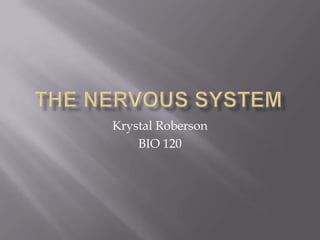Nervous System Suffixes
- 1. Krystal Roberson BIO 120
- 2. ïĻ Coordinates the actions of the body and transmits signals between different parts of the body ïĻ Consists of the central nervous system and the peripheral nervous system
- 3. ïĻ Integrate information it receives and coordinates the activity of all parts of the body ïĻ Consists of the brain and spinal cord
- 4. ïĻ Consists of nerves that connect the CNS to the rest of the body ïĻ Includes motor neurons, the autonomous nervous system, the sympathetic nervous system, and the parasympathetic nervous system
- 5. ïĻ -esthesia: Feeling; sensation ïĻ -phasia: Speech
- 6. ïĻ Having sensation blocked or temporarily taken away ïĻ Medically induced and reversible ïĄ Allows patients to undergo surgery and other procedures without pain ïĻ Types include: Local, regional, general, and dissociative anesthesia
- 7. ïĻ Abnormal increase in sensitivity to stimuli of the sense ïĻ Tactile- Increased sensitivity to touch ïĻ Auditory â Increased sensitivity to sound
- 8. ïĻ Lack of speech ïĻ Ranges from difficulty remembering words to being completely unable to speak, read, or write ïĻ Can develop due to head injury or stroke
- 9. ïĻ Difficult speech ïĻ Subtypes include: Expressive, receptive, and global dysphasia ïĻ Can affect comprehension, naming, repetition, and speech








